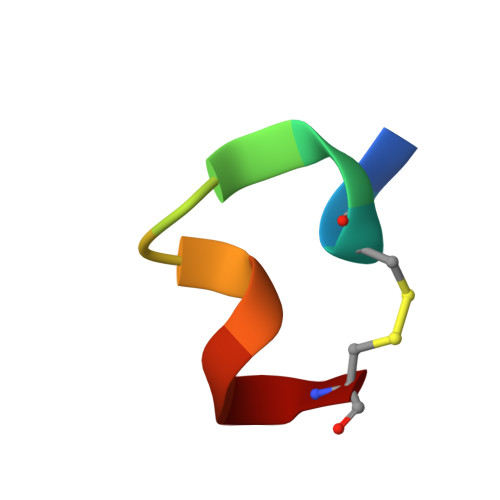{alpha}-Selenoconotoxins, a New Class of Potent {alpha}7 Neuronal Nicotinic Receptor Antagonists.
Armishaw, C.J., Daly, N.L., Nevin, S.T., Adams, D.J., Craik, D.J., Alewood, P.F.(2006) J Biological Chem 281: 14136-14143
- PubMed: 16500898
- DOI: https://doi.org/10.1074/jbc.M512419200
- Primary Citation of Related Structures:
2BC7, 2BC8 - PubMed Abstract:
Disulfide bonds are important structural motifs that play an essential role in maintaining the conformational stability of many bioactive peptides. Of particular importance are the conotoxins, which selectively target a wide range of ion channels that are implicated in numerous disease states. Despite the enormous potential of conotoxins as therapeutics, their multiple disulfide bond frameworks are inherently unstable under reducing conditions. Reduction or scrambling by thiol-containing molecules such as glutathione or serum albumin in intracellular or extracellular environments such as blood plasma can decrease their effectiveness as drugs. To address this issue, we describe a new class of selenoconotoxins where cysteine residues are replaced by selenocysteine to form isosteric and nonreducible diselenide bonds. Three isoforms of alpha-conotoxin ImI were synthesized by t-butoxycarbonyl chemistry with systematic replacement of one ([Sec(2,8)]ImI or [Sec(3,12)]ImI), or both ([Sec(2,3,8,12)]ImI) disulfide bonds with a diselenide bond. Each analogue demonstrated remarkable stability to reduction or scrambling under a range of chemical and biological reducing conditions. Three-dimensional structural characterization by NMR and CD spectroscopy indicates conformational preferences that are very similar to those of native ImI, suggesting fully isomorphic structures. Additionally, full bioactivity was retained at the alpha7 nicotinic acetylcholine receptor, with each selenoanalogue exhibiting a dose-response curve that overlaps with wild-type ImI, thus further supporting an isomorphic structure. These results demonstrate that selenoconotoxins can be used as highly stable scaffolds for the design of new drugs.
- Institute for Molecular Bioscience, University of Queensland, Brisbane, Queensland 4072, Australia.
Organizational Affiliation:
















